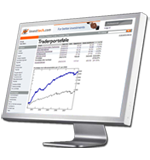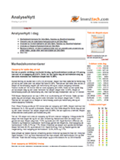Investtech Research: Strongest signals in low-liquidity stocks
Published 13 June 2024
Background and Objectives
Previous research by Investtech suggests that technical signals perform better in small companies than in large companies. We have now summarized the extensive data and research work we conducted during the winter and spring of 2021. We examined data from all listed companies in Norway, Sweden, Denmark, and Finland for the years 2008-2020. We studied signal types including Trends, Support and Resistance, Price Formations, Volume Balance, Momentum, and Insider Trading.
For references on research reports on the individual signals, see the literature list.
We chose to focus on the most important and largest subtypes of signals from each of the above categories: Within rising/falling trend channels, Break upwards through resistance/break downwards through support, Rectangles and Head-and-shoulders formations, High/low volume balance, High/low RSI momentum, and Insider buying/selling.
In total, this comprised 254,548 signals, divided into 150,380 buy signals and 104,168 sell signals. We defined small companies and large companies as stocks with an average daily turnover of between 0.5 and 5 million NOK and over 5 million NOK, respectively.
The signals were roughly equally distributed between large and small companies, with a total of 128,089 signals from small companies and 126,459 signals from large companies.
We wanted to see if there were systematic differences between the groups.
Example buy signal: Within a rising trend channel
The charts below show average price development following buy signal from stocks being within a rising trend channel. The signals are triggered on day 0. Only days when the exchange is open are included, so 66 days equal approximately three months. The thick blue line shows the development of buy signal stocks. The shaded areas are the standard deviation of the calculations. The thin blue line shows benchmark development in the same period as the buy signal stocks.
Two charts are shown, for low-liquidity and high-liquidity companies respectively, referred to as Small companies and Large companies. The charts apply to the Nordic markets as a whole. Click the images for bigger version.
| Relative return after 66 days | Norway | Sweden | Denmark | Finland | Weighted average |
| Excess return buy signal Small companies | 2.2 %p | 2.5 %p | 1.5 %p | 2.3 %p | 2.3 %p |
| Excess return buy signal Large companies | 1.0 %p | 0.9 %p | 0.9 %p | 0.6 %p | 0.9 %p |
Example sell signal: Within a falling trend channel
| Relative return after 66 days | Norge | Sverige | Danmark | Finland | Weighted average |
| Excess return sell signal Small companies | -4.0 %p | -1.7 %p | -2.8 %p | -0.5 %p | -2.2 %p |
| Excess return sell signal Large companies | -3.2 %p | 0.4 %p | -0.8 %p | 1.7 %p | -0.4 %p |
Results and recommendations
The examples above show results for rising and falling trends, which together make up about a quarter of the total dataset. We see that both buy and sell signals have performed better for small companies than for large companies, and that the results are quite consistent across the four markets.
The same largely applies to the other signal types. Annualized figures for all the signals we examined show that small companies with buy signals were followed by an annualized excess return of 6.6 percentage points, while large companies with buy signals were followed by an excess return of 2.9 percentage points.
Several factors can explain such an effect:
*First, small companies are less analyzed than large companies and receive less attention in the press. It can therefore take longer for company-specific or industry-specific information to become known to investors, and the information can be disclosed at different times. When some begin to trade on the information, this will often trigger technical signals, and when others later follow, the stocks will continue in the same direction.
*The second factor is that small companies have low liquidity on the stock exchange. In our dataset, we included stocks with an average daily turnover of between half a million and five million NOK. If a large investor or a large stock fund wants to build a position in a small company, it will often take many days to complete the trade. A technical signal can thus be the start of further buy or sell interest in the same direction. For example, if a large investor wants to invest 10 million NOK in a stock that trades for 2 million NOK daily on average, the transaction could easily take several weeks.
*A final explanation may be that news and changing market conditions often have a larger relative effect on small companies than on large companies. This can lead to greater price movements for small companies.
Regardless of the explanation, the differences seem to be statistically significant: The signals have worked better for small companies than for large companies. By consistently focusing on small companies and signals in small companies, the results indicate good opportunities for achieving better returns than the market as a whole, but also better returns than for large companies with corresponding buy signals.
Note that the signals for large companies also predominantly show excess return vs the market, and stocks with sell signals underperform. Systematic use of technical analysis can yield good results and excess return vs the market also for large companies.
In our statistics we used data from 2008-2020 and a liquidity threshold of five million NOK. Liquidity on the stock exchange has increased during this period, and it may be that many stocks that were previously in the small companies group now fall under large companies. We consider this not as a fixed limit but rather as a sliding transition between small and large companies. We set the limit to study if there are differences between large and small companies. Simple tests indicate that there are statistically significant results for medium-sized companies as well, and that it is primarily the largest companies, such as OBX, OMX and C20 companies, that weaken the results for large companies.
Literature
- Geir Linløkken et co. Investtech research: Volume balance - signal statistics Nordics markets 2019 and 2020, (Norwegian only), Investtech 2021.
- Geir Linløkken et co. Investtech research: Insider trades - signal statistics Scandinavia 2008 - 2020, (Norwegian only), Investtech 2021.
- Geir Linløkken. Investtech research: Return following signals from price formations in stock prices, Nordic markets 1996-2018, Investtech 2020.
- Geir Linløkken, Asbjørn Taugbøl, Fredrik Tyvand. Investtech research: Support and resistance - signal statistics Nordic markets 2019 and 2020, (Norwegian only), Investtech 2021.
- Geir Linløkken, Asbjørn Taugbøl, Fredrik Tyvand. Investtech research: Insider trades - signal statistics Norway, Sweden and Denmark 2019 and 2020, (Norwegian only), Investtech 2021.
- Geir Linløkken. Volume balance - signal statistics Nordic markets 1996 - 2018, (Norwegian only), Investtech 2020.
- Geir Linløkken, Asbjørn Taugbøl, Fredrik Tyvand. Investtech research: Return following testing of and breaks through support and resistance in stock prices, the Nordic markets, 1996-2018, Investtech 2019.
- Asbjørn Taugbøl. Stocks in rising trends have given excess return in the Nordic markets, Investtech 2019.
- Asbjørn Taugbøl. Trend signals better than theory suggests, Investtech 2019.
- Geir Linløkken. Insider purchase as indicator of further price development in the stock, (Norwegian only), Investtech 2019.
- Geir Linløkken. RSI is a good momentum indicator, Investtech 2019.
- Geir Linløkken. Return following signals from rectangle formations in stock prices - medium term, Nordic markets, 1996-2018, Investtech 2019.
- Geir Linløkken and Steffen Frölich. Technical Stock Analysis - for lower risk and increased return. Investtech.com, 2001.
- John J. Murphy. Technical Analysis of the Financial Markets. New York Institute of Finance, 1999.
Keywords: Buy signal,Helsingfors,Kjøpssignal,København,Momentum,Oslo,Salgssignal,Sell signal,statistics,statistikk,Stockholm.
Verfasst von

Forschungs- und Analysechef
Investtech
Insight & skills:
"Investtech analysiert die Psychologie des Marktes und macht Ihnen täglich konkrete Tradingvorschläge."

Partner & Senior Advisor - Investtech
Die Anlageempfehlungen werden von Investtech.com AS ("Investtech") ausgearbeitet. Investtech übernimmt keine Haftung für die Vollständigkeit oder Richtigkeit der jeweiligen Analyse. Ein etwaiges Engagement aufgrund der aus den Analysen resultierenden Empfehlungen/Signale erfolgt zur Gänze für Rechnung und Risiko des Anlegers. Investtech haftet nicht für Verluste, die sich direkt oder indirekt infolge der Nutzung von Investtechs Analysen ergeben. Angaben zu etwaigen Interessenkonflikten gehen stets aus der Anlageempfehlung hervor. Weitere Informationen zu Investtechs Analysen finden Sie unter disclaimer.
Die Anlageempfehlungen werden von Investtech.com AS ("Investtech") ausgearbeitet. Investtech übernimmt keine Haftung für die Vollständigkeit oder Richtigkeit der jeweiligen Analyse. Ein etwaiges Engagement aufgrund der aus den Analysen resultierenden Empfehlungen/Signale erfolgt zur Gänze für Rechnung und Risiko des Anlegers. Investtech haftet nicht für Verluste, die sich direkt oder indirekt infolge der Nutzung von Investtechs Analysen ergeben. Angaben zu etwaigen Interessenkonflikten gehen stets aus der Anlageempfehlung hervor. Weitere Informationen zu Investtechs Analysen finden Sie unter disclaimer.


 Oslo Børs
Oslo Børs Stockholmsbörsen
Stockholmsbörsen Københavns Fondsbørs
Københavns Fondsbørs Helsingin pörssi
Helsingin pörssi World Indices
World Indices US Stocks
US Stocks Toronto Stock Exchange
Toronto Stock Exchange London Stock Exchange
London Stock Exchange Euronext Amsterdam
Euronext Amsterdam Euronext Brussel
Euronext Brussel DAX
DAX CAC 40
CAC 40 Mumbai S.E.
Mumbai S.E. Commodities
Commodities Currency
Currency Cryptocurrency
Cryptocurrency Exchange Traded Funds
Exchange Traded Funds Investtech Indices
Investtech Indices


